The Jewish Federations of North America (JFNA) have joined together with the various Jewish denominational movements, and now with ADL and American Jewish Committee, to promote a North American- wide Solidarity Shabbat this weekend following the horrific shooting in Pittsburgh last week. Here is a compilation of resource material that synagogues and other partners may find helpful as they consider how they want to facilitate Shabbat services and programs this weekend.
The materials were prepared by JFNA’s Jewish Education and Engagement office and also provide links to other resources that may be helpful.
Memory — Yizkor
Synagogues and communities might choose to share the names of those murdered during the Mourners’ Kaddish or as Shabbat is welcomed.
As we light the Shabbat candles, we invite into our presence the memory of those who cannot be with us. We bring them into our bodies and hearts; we speak their names out loud. We honor what they gave in the face of hatred.
Joyce Fienberg, 75
Richard Gottfried, 65
Rose Mallinger, 97
Jerry Rabinowitz, 66
Cecil Rosenthal, 59
David Rosenthal, 54
Bernice Simon, 84
Sylvan Simon, 86
Daniel Stein, 71
Melvin Wax, 87
Irving Younger, 69
Reading and Song
Synagogues and communities might choose to include these pieces in prayer services.
Reading: Sh’ma – Communal Declaration of Faith (Marcia Falk, “The Book of Blessings”)
Hear, Oh Israel
The divine abounds everywhere and dwells in everything; the many are One.
Loving life and its mysterious source with all our heart and all our spirit,
All our senses and strength, we take upon ourselves and into ourselves these promises:
To care for the earth and those who live upon it,
To pursue justice and peace, to love kindness and compassion.
We will teach this to our children throughout the passage of the day—as we dwell in our homes and as we go on our journeys, from the time we rise until we fall asleep.
And may our actions be faithful to our words, that our children’s children may live to know: Truth and kindness have embraced, peace and justice have kissed and are one.
Song: Gesher Tzar Meod (Rabbi Nachman of Bratzlav)
All the world is a narrow bridge, and the main thing to do is not to be afraid.
Texts
Synagogues and communities may use these texts as part of a d’var Torah or for study and discussion. Questions follow each text.
Text #1: Olam Chesed Yibaneh
Core text: Psalm 89: 2-5
I will sing of the LORD’s steadfast love forever; to all generations I will proclaim Your faithfulness with my mouth. I declare, “Your steadfast love is confirmed forever; there in the heavens You establish Your faithfulness. I have made a covenant with My chosen one; I have sworn to My servant David: I will establish your offspring forever, I will confirm your throne for all generations.” Selah.
Commentary:
Psalm 89, line 3—“olam chesed yibaneh”—is translated literally as, “God’s love is everlasting.” And, it has been adapted to suggest, “God builds the world from love,” and even, “We will build the world from love.” It is the context of the Psalm that gives the line its meaning: The Psalmist laments, God, you’ve broken your covenant with your people! What happened to our world! The adapted translation suggested that we provide the answer: We must work together to apply God’s love to our broken world, and to build our world through love for each other.
For discussion:
- What does it mean to love each other? What other emotions and connections does love hold?
- How can we love even in the face of tragedy and hate?
- How does love build the world?
- How can we speak of God’s love in the face of tragedy?
- What is the relationship between God’s everlasting love and our love for the world? How does our love facilitate God’s love?
Text #2: The Place of One Soul
Core text: Mishnah Sanhedrin 4:5
It was for this reason that humans were first created as one person: To teach that anyone who destroys a life is considered to have destroyed an entire world, and anyone who saves a life is as if he saved an entire world.
Commentary:
Rabbi Lord Jonathan Sacks, at the 2016 JFNA General Assembly):
[If] we truly believe that one life is like an entire universe, then all you have to do is change one life, and you’ve begun to change the universe the only way we can, one life at a time, one day at a time, one act at a time. So when, out there, there is despair, let us bring hope. When out there, there is hurt, let us heal. And when out there is division, let us show that we are enlarged and not diminished by our differences. Let us show the world what it is to stand together and respect one another.
Therefore, I say this, never waste a crisis. Never stand still. Go out there, continue the Jewish journey, and be a blessing to the Jewish people, and to the world.
For discussion:
- How does Rabbi Sacks move from changing one life to healing and action? What is the thread that he weaves through his words?
- What does it mean to be a blessing to the Jewish people—and to the world?
- Why might Rabbi Sacks include the Jewish people and the world? How can we balance commitment to strengthening both our particular people and our universal world?
Text #3: Community and Responsibility
Core text: Rabbi Yom Tov ben Avraham Isbili (Ritva) on Babylonian Talmud Rosh Hashanah 29a
Because even though the commandments are placed upon each individual, all Jews are guarantors of one another, and they are all a single body, and it is like a guarantor who repays the debt of his friend.
Commentary:
Rabbi Joseph Soloveitchik, Kol Dodi Dofek, at Yeshiva University on Yom HaAtzmaut, 1956 :
The authoritative ruling is that as long as there is shared suffering, in the manner of “I will be with him in trouble” (Psalms 91:5), there is unity. If the Jew upon whom divine providence has shed a beneficent light, and who consequently believes that, at least with respect to him, the venom of hate and rejection has been expunged from his surroundings, still feels the troubles of his people and the burden of a fate-laden existence, then his link with the people has not been broken. If boiling water is poured upon the head of the Jew in Morocco, the fashionably-attired Jew in London or Paris has to scream at the top of his voice, and through feeling the pain he will remain faithful to his people. The fragmentation of the people and the blearing of its image are concomitants of the absence of the feeling of sympathy.
For discussion:
- What does it mean to be someone’s guarantor, or to be the guarantor of a people?
- How is Rav Soloveitchik shedding light on the maxim that all Jews are responsible for each other?
- What does it mean to feel someone else’s pain? Can we let it go? Why not?
Working with Different Audiences
Solidarity Shabbat might be shaped for different audiences in the following ways.
Families with Young Children:
- Expect the wiggles! Create a play area or provide toys, coloring books (if Shabbat-appropriate for your environment), or books for young children.
- Consider offering dinner (pizza, not fancy!) before/after prayer services. Make sure to share names and otherwise welcome people and build community during the meal. Or, have this event at a home nearby the synagogue—the meal becomes more welcoming and the host family’s toys make it easier for kids to be distracted and adults to get to know each other.
- Offer families an opportunity to leave the sanctuary for a story read in another space. Consider offering Kiddush and challah after the story, enticing families to stay and schmooze. (See these PJ Library books particularly related to this issue.)
- Make sure that marketing materials share all of this, letting families know that they’re welcome and will be comfortable in the moment.
- Feel free to contact your community’s PJ Library professional, letting them know that this is happening—they can help get the word out and support your work.
Families with Grade-School Children:
- Adapt some of the suggestions for families with young children—meals and gatherings and stories and activities.
- Provide some materials for discussion, drawing from the resources below. Open space for conversation, asking children to share what they know and questions they might have. (This should only be done with experienced professionals and older children/teens. Talking points, drawn from resources below, should be developed.)
20/30 Somethings:
- Create intentional space for open conversation.
- Consider adding a reading of one of these texts to an already scheduled event or sharing a post with a text or prayer on social media.
- Create text studies of the texts and discussion questions provided.
Additional Resources
As you plan gatherings, the following resources might help craft discussions and create spaces for grieving and support.
- Edutopia resources for children and families dealing with trauma
- PBS guide for processing the news with children of various ages
- Commentary and resources from Teaching Tolerance on dealing with hate
- Moving Traditions guide for talking with teens about Pittsburgh
- Facing History and Ourselves guide for talking about anti-Semitism
- Jewish Education Center of Cleveland’s extensive curriculum site on trauma and tragedy
- M2 resources for educators working with students of all ages in this time
- Congregation B’nai Jeshurun’s Service of Solidarity
- Rabbi Paul Kipnes’ Kaddish after gun violence






